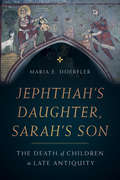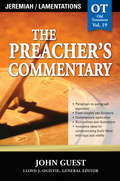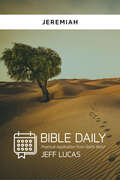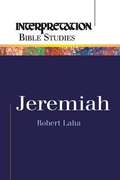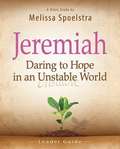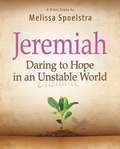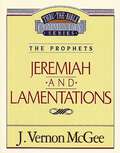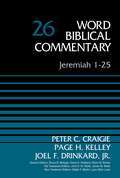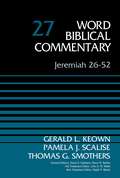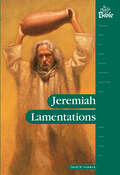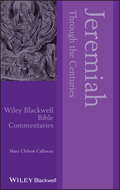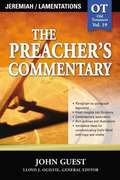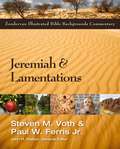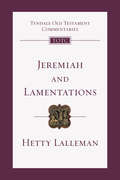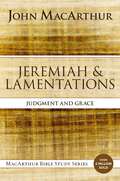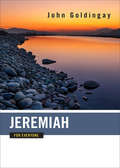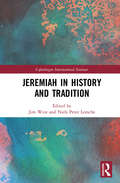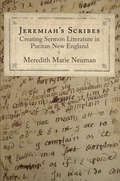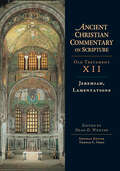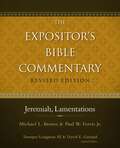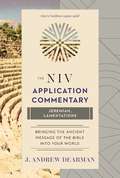- Table View
- List View
Jephthah’s Daughter, Sarah’s Son: The Death of Children in Late Antiquity (Christianity in Late Antiquity #8)
by Maria E. DoerflerLate antiquity was a perilous time for children, who were often the first victims of economic crisis, war, and disease. They had a one in three chance of dying before their first birthday, with as many as half dying before age ten. Christian writers accordingly sought to speak to the experience of bereavement and to provide cultural scripts for parents who had lost a child. These late ancient writers turned to characters like Eve and Sarah, Job and Jephthah as models for grieving and for confronting or submitting to the divine. Jephthah's Daughter, Sarah’s Son traces the stories these writers crafted and the ways in which they shaped the lived experience of familial bereavement in ancient Christianity. A compelling social history that conveys the emotional lives of people in the late ancient world, Jephthah's Daughter, Sarah's Son is a powerful portrait of mourning that extends beyond antiquity to the present day.
Jeremiah & Lamentations (The Preacher's Commentary)
by John GuestGeneral editor Lloyd J. Ogilvie brings together a team of skilled and exceptional communicators to blend sound scholarship with life-related illustrations.The design for the Preacher's Commentary gives the reader an overall outline of each book of the Bible. Following the introduction, which reveals the author's approach and salient background on the book, each chapter of the commentary provides the Scripture to be exposited. The New King James Bible has been chosen for the Preacher's Commentary because it combines with integrity the beauty of language, underlying Hebrew and Greek textual basis, and thought-flow of the 1611 King James Version, while replacing obsolete verb forms and other archaisms with their everyday contemporary counterparts for greater readability. Reverence for God is preserved in the capitalization of all pronouns referring to the Father, Son, or Holy Spirit. Readers who are more comfortable with another translation can readily find the parallel passage by means of the chapter and verse reference at the end of each passage being exposited. The paragraphs of exposition combine fresh insights to the Scripture, application, rich illustrative material, and innovative ways of utilizing the vibrant truth for his or her own life and for the challenge of communicating it with vigor and vitality.
Jeremiah & Lamentations- Everyman's Bible Commentary (Everyman's Bible Commentaries)
by Irving L. JensenJeremiah, previously published as a separate volume, has been combined with Lamentations to provide a carefully organized exposition that reconstructs the historical and cultural backgrounds as well as the vital message of the two Old Testament books.Jeremiah is a penetrating analysis of a significant prophetic book regarded as especially relevant to modern times. Lamentations is an appropriate companion to this book, for it looks back to the event that Jeremiah anticipated, the fall of Jerusalem, and describes in stunningly evocative language the grief that Israel experienced. Using a paragraph-by-paragraph method of analysis, Dr. Jensen explores major units of thought in these biblical books. He effectively uses charts, maps, and informative footnotes to aid the reader's understanding.
Jeremiah & Lamentations- Everyman's Bible Commentary (Everyman's Bible Commentaries)
by Irving L. JensenJeremiah, previously published as a separate volume, has been combined with Lamentations to provide a carefully organized exposition that reconstructs the historical and cultural backgrounds as well as the vital message of the two Old Testament books.Jeremiah is a penetrating analysis of a significant prophetic book regarded as especially relevant to modern times. Lamentations is an appropriate companion to this book, for it looks back to the event that Jeremiah anticipated, the fall of Jerusalem, and describes in stunningly evocative language the grief that Israel experienced. Using a paragraph-by-paragraph method of analysis, Dr. Jensen explores major units of thought in these biblical books. He effectively uses charts, maps, and informative footnotes to aid the reader's understanding.
Jeremiah (Bible Daily Notes: Practical Application from God's Word)
by Jeff LucasAsk any Christian to name their favorite books in the Bible and you&’re unlikely to find the book of Jeremiah at the top of any list—or even on any list. Frankly, most of us tend to ignore this deeply sad book completely. Beginning as a young man, Jeremiah prophesied under five kings, and his prophecies were never listened to—or at least not obeyed. Yet Jeremiah has a lot to say to us today. As he tearfully tells us about what life without God looks like, his message of conviction, repentance, and faith has startling relevance to our modern world. Our Bible notes on Jeremiah focus not on the history but on the message the prophet brought to a nation that was light-years away from God and about to experience judgment. Thank you for going on this journey, as we consider the call and message of this young twentysomething who lived over twenty-six hundred years ago but who definitely has some important things to say to us. Bible Daily notes are written by Jeff Lucas to help you apply the lessons of God&’s Word daily. Each day and with each devotion, Jeff uses his signature wit and wisdom to reveal insights and practical application you can use in your own life. Each Bible devotion takes only a few minutes to read, but the lessons learned can last a lifetime.
Jeremiah (Interpretation Bible Studies)
by Robert R. Laha Jr.In this book, Robert Laha leads a ten-session study into the stories of suffering, blame, and, ultimately, hope found in the book of Jeremiah. In an attempt to bring some clarity to this at times confusing book, Laha discusses Jeremiah's world and God's judgement; prophetic signs and false prophets; unfaithfulness and lament; and consolation and hope. Interpretation Bible Studies (IBS) offers solid biblical content in a creative study format. Forged in the tradition of the celebrated Interpretation commentary series, IBS makes the same depth of biblical insight available in a dynamic, flexible, and user-friendly resource. Designed for adults and older youth, IBS can be used in small groups, in church school classes, in large group presentations, or in personal study.
Jeremiah - Women's Bible Study Leader Guide: Daring to Hope in an Unstable World (Jeremiah)
by Melissa SpoelstraLearn to surrender to God’s will and rest your hope in Him alone.When we look around at today’s world, hope usually isn’t the first word that comes to mind. In many ways we live in an unstable world where marriages fail, bank accounts run low, friendships end, and the everyday demands of a fast-paced life get us down. In the Book of Jeremiah, we find God calling out to His people with a message of hope—a message that intentional living is possible even in an unstable world. But how do we do this? Where do we start? Jeremiah offers women hope for living in an uncertain world by learning to navigate the challenges and circumstances of their lives. This six-week study examines God’s words of instruction to His wayward people through the prophet Jeremiah, and provides women six guidelines for intentional living to overcome fear, worry, and doubt as they surrender their wills to God’s and put their hope in Him alone. Combining rich study of the Book of Jeremiah with practical life application that resonates with the realities and experiences of today’s women, this study inspires all women to dare to hope, remembering that God is rich in mercy and love and has good plans for us.The Leader Guide contains six session plan outlines, complete with discussion points and questions, activities, prayers, and more—plus leader helps for facilitating a group.Other components for the Bible study, available separately, include a Participant Workbook, DVD with six 20-25 minute sessions, and boxed Leader Kit (an all-inclusive box containing one copy of each of the Bible study’s components).
Jeremiah - Women's Bible Study Participant Book: Daring to Hope in an Unstable World (Jeremiah)
by Melissa SpoelstraLearn to surrender to God’s will and rest your hope in Him alone.When we look around at today’s world, hope usually isn’t the first word that comes to mind. In many ways we live in an unstable world where marriages fail, bank accounts run low, friendships end, and the everyday demands of a fast-paced life get us down. In the Book of Jeremiah, we find God calling out to His people with a message of hope—a message that intentional living is possible even in an unstable world. But how do we do this? Where do we start?Jeremiah offers women hope for living in an uncertain world by learning to navigate the challenges and circumstances of their lives. This six-week study examines God’s words of instruction to His wayward people through the prophet Jeremiah, and provides women six guidelines for intentional living to overcome fear, worry, and doubt as they surrender their wills to God’s and put their hope in Him alone.Combining rich study of the Book of Jeremiah with practical life application that resonates with the realities and experiences of today’s women, this study inspires all women to dare to hope, remembering that God is rich in mercy and love and has good plans for us.The participant workbook includes five days of lessons for each week, combining study of Scripture with personal reflection, application, and prayer.Other components for the Bible study, available separately, include a Leader Guide, DVD with six 20-25 minute sessions, and boxed Leader Kit (an all-inclusive box containing one copy of each of the Bible study’s components).
Jeremiah - Women's Bible Study Preview Book: Daring to Hope in an Unstable World
by Melissa SpoelstraThis pocket-size book provides a snapshot of the underlying message of the complete study—that by surrendering our wills to God and placing our hope in Him alone will help us live intentionally in an unstable world. Based on the Bible study: Jeremiah: Daring to Hope in an Unstable World.
Jeremiah / Lamentations: The Prophets (Thru the Bible #24)
by J. Vernon McgeeRadio messages from J. Vernon McGee delighted and enthralled listeners for years with simple, straightforward language and clear understanding of the Scripture. Now enjoy his personable, yet scholarly, style in a 60-volume set of commentaries that takes you from Genesis to Revelation with new understanding and insight. Each volume includes introductory sections, detailed outlines and a thorough, paragraph-by-paragraph discussion of the text. A great choice for pastors - and even better choice for the average Bible reader and student! Very affordable in a size that can go anywhere, it's available as a complete 60-volume series, in Old Testament or New Testament sets, or individually.
Jeremiah 1-25 (Word Biblical Commentary #26)
by Bruce M. Metzger Ralph P. Martin Lynn Allan Losie David Allen Hubbard Glenn W. Barker John D. Watts James W. Watts Peter C. Craigie Paige Kelley Dr Joel F. DrinkardThe Word Biblical Commentary delivers the best in biblical scholarship, from the leading scholars of our day who share a commitment to Scripture as divine revelation. This series emphasizes a thorough analysis of textual, linguistic, structural, and theological evidence. The result is judicious and balanced insight into the meanings of the text in the framework of biblical theology. These widely acclaimed commentaries serve as exceptional resources for the professional theologian and instructor, the seminary or university student, the working minister, and everyone concerned with building theological understanding from a solid base of biblical scholarship.Overview of Commentary OrganizationIntroduction—covers issues pertaining to the whole book, including context, date, authorship, composition, interpretive issues, purpose, and theology.Each section of the commentary includes:Pericope Bibliography—a helpful resource containing the most important works that pertain to each particular pericope.Translation—the author’s own translation of the biblical text, reflecting the end result of exegesis and attending to Hebrew and Greek idiomatic usage of words, phrases, and tenses, yet in reasonably good English.Notes—the author’s notes to the translation that address any textual variants, grammatical forms, syntactical constructions, basic meanings of words, and problems of translation.Form/Structure/Setting—a discussion of redaction, genre, sources, and tradition as they concern the origin of the pericope, its canonical form, and its relation to the biblical and extra-biblical contexts in order to illuminate the structure and character of the pericope. Rhetorical or compositional features important to understanding the passage are also introduced here.Comment—verse-by-verse interpretation of the text and dialogue with other interpreters, engaging with current opinion and scholarly research.Explanation—brings together all the results of the discussion in previous sections to expose the meaning and intention of the text at several levels: (1) within the context of the book itself; (2) its meaning in the OT or NT; (3) its place in the entire canon; (4) theological relevance to broader OT or NT issues.General Bibliography—occurring at the end of each volume, this extensive bibliographycontains all sources used anywhere in the commentary.
Jeremiah 26-52 (Word Biblical Commentary #27)
by Ralph P. Martin David Allen Hubbard Glenn W. Barker John D. Watts Dr Gerald Keown Pamela Scalise Thomas G. SmothersThe Word Biblical Commentary delivers the best in biblical scholarship, from the leading scholars of our day who share a commitment to Scripture as divine revelation. This series emphasizes a thorough analysis of textual, linguistic, structural, and theological evidence. The result is judicious and balanced insight into the meanings of the text in the framework of biblical theology. These widely acclaimed commentaries serve as exceptional resources for the professional theologian and instructor, the seminary or university student, the working minister, and everyone concerned with building theological understanding from a solid base of biblical scholarship.Overview of Commentary OrganizationIntroduction—covers issues pertaining to the whole book, including context, date, authorship, composition, interpretive issues, purpose, and theology.Each section of the commentary includes:Pericope Bibliography—a helpful resource containing the most important works that pertain to each particular pericope.Translation—the author’s own translation of the biblical text, reflecting the end result of exegesis and attending to Hebrew and Greek idiomatic usage of words, phrases, and tenses, yet in reasonably good English.Notes—the author’s notes to the translation that address any textual variants, grammatical forms, syntactical constructions, basic meanings of words, and problems of translation.Form/Structure/Setting—a discussion of redaction, genre, sources, and tradition as they concern the origin of the pericope, its canonical form, and its relation to the biblical and extra-biblical contexts in order to illuminate the structure and character of the pericope. Rhetorical or compositional features important to understanding the passage are also introduced here.Comment—verse-by-verse interpretation of the text and dialogue with other interpreters, engaging with current opinion and scholarly research.Explanation—brings together all the results of the discussion in previous sections to expose the meaning and intention of the text at several levels: (1) within the context of the book itself; (2) its meaning in the OT or NT; (3) its place in the entire canon; (4) theological relevance to broader OT or NT issues.General Bibliography—occurring at the end of each volume, this extensive bibliographycontains all sources used anywhere in the commentary.
Jeremiah Lamentations (The People's Bible)
by David M GosdeckWhat is the book of Jeremiah about? What is the book of Lamentations about?In the last days before the people of Judah were carried off in exile, God sent his prophet Jeremiah to announce the coming judgment, call people to repentance, and comfort the believers who lived in a nation that had forsaken the Lord. Jeremiah’s testimony contains many glorious prophecies of the coming Messiah. The book of Lamentations in the Bible encourages believers to cling to the Lord and his promises—even in times of disaster.Want to learn more? If you’re wondering what the books of Jeremiah and Lamentations are all about, this helpful resource is for you!Jeremiah, Lamentations is a reliable Bible commentary. It’s down to earth, clearly written, easy to read and understand, and filled with practical and modern applications to Scripture.It also includes the complete text of the books of Jeremiah and Lamentations from the NIV Bible. The Christ-centered commentaries following the Scripture sections contain explanations of the text, historical background, illustrations, and archaeological information. Jeremiah, Lamentations is a great resource for personal or group study!This book is a part of The People’s Bible series from Northwestern Publishing House.
Jeremiah Through the Centuries (Wiley Blackwell Bible Commentaries)
by Mary Chilton CallawayExplores the interpretive history of the Book of Jeremiah, and highlights the various ways it has influenced the cultures in which it was read Jeremiah Through the Centuries explores the reception history of the sixth century B.C.E. prophet, providing original commentary on the texts and traditions that continue to deeply impact readers by exemplifying the spiritual struggle of the faithful. Focusing on the Book of Jeremiah, the text presents an original theory about the effects of Jeremiah on the developing idea of the self in Western history and culture, particularly over the last 400 years, in a wide range of liturgical, political, artistic, literary, and cultural contexts. The book guides readers through various interpretations of Jeremiah’s poetry and prose, discussing the profound influence that Jeremiah and Western culturehave had on each other through the centuries. Significant texts from every chapter of Jeremiah are presented in a chronological narrative as both conversation and debate—enabling readers to encounter the prophet in the text of the Bible, in previous interpretations, and in the context of their own lives. Throughout the text, the receptions reflect historical contexts and highlight the ways they shaped specific receptions of Jeremiah. This book: Illustrates how the Book of Jeremiah was adapted by readers to face new challenges, both in the past and present Includes examples of Jeremiah in social satire, Islamic tradition, political debate, and religious controversy Provides a detailed introduction that traces Jeremiah’s influence on events and traditions Offers insights into both celebrated texts and lesser-known passages that are relevant to contemporary readers Features numerous, previously unpublished, illustrations, demonstrating the influence of Jeremiah on traditions in Western art Featuring engaging narrative and expert commentary, Jeremiah Through the Centuries is ideal for students, teachers, and general readers with interest in theology and biblical studies, Judaic studies, ancient literature, cultural criticism, reception history of the Bible, and the history of Western civilization.
Jeremiah and Lamentations (Preacher's Commentary, Volume #19)
by John GuestGeneral editor Lloyd J. Ogilvie brings together a team of skilled and exceptional communicators to blend sound scholarship with life-related illustrations. The design for the Preacher's Commentary gives the reader an overall outline of each book of the Bible. Following the introduction, which reveals the author's approach and salient background on the book, each chapter of the commentary provides the Scripture to be exposited. The New King James Bible has been chosen for the Preacher's Commentary because it combines with integrity the beauty of language, underlying Hebrew and Greek textual basis, and thought-flow of the 1611 King James Version, while replacing obsolete verb forms and other archaisms with their everyday contemporary counterparts for greater readability. Reverence for God is preserved in the capitalization of all pronouns referring to the Father, Son, or Holy Spirit. Readers who are more comfortable with another translation can readily find the parallel passage by means of the chapter and verse reference at the end of each passage being exposited. The paragraphs of exposition combine fresh insights to the Scripture, application, rich illustrative material, and innovative ways of utilizing the vibrant truth for his or her own life and for the challenge of communicating it with vigor and vitality.
Jeremiah and Lamentations (Zondervan Illustrated Bible Backgrounds Commentary)
by John H. Walton Steven M. Voth Paul W. FerrisMany today find the Old Testament a closed book. The cultural issues seem insurmountable and we are easily baffled by that which seems obscure. Furthermore, without knowledge of the ancient culture we can easily impose our own culture on the text, potentially distorting it. This series invites you to enter the Old Testament with a company of guides, experts that will give new insights into these cherished writings. Features include • Over 2000 photographs, drawings, maps, diagrams and charts provide a visual feast that breathes fresh life into the text. • Passage-by-passage commentary presents archaeological findings, historical explanations, geographic insights, notes on manners and customs, and more. • Analysis into the literature of the ancient Near East will open your eyes to new depths of understanding both familiar and unfamiliar passages. • Written by an international team of 30 specialists, all top scholars in background studies.
Jeremiah and Lamentations: An Introduction and Commentary (Tyndale Old Testament Commentaries #21)
by Hetty LallemanDespite the themes of doom and destruction, the primary message of Jeremiah is one of the love and grace of a God who never gives up on those he has called to be his own. The prophet's life is characterized by suffering, but he points to a new beginning, a new covenant and a new hope, eventually made possible through the unique Suffering Servant. Lamentations powerfully expresses personal and national suffering. Yet, even in these utterances of desperate grief, there are glimpses of hope. Lifting out these significant but understated themes in Jeremiah and Lamentations, this commentary by Hetty Lalleman opens our eyes to an important chapter in salvation history.
Jeremiah and Lamentations: Judgment and Grace (MacArthur Bible Studies)
by John F. MacArthurThe prophet Jeremiah ministered during the waning decades of Judah. The people had rebelled against the Lord through their constant idolatry and injustice of all kinds—and they were about to experience God's wrath in the form of a conquering army. Yet even as Jeremiah described the short-term consequences of the people's rebellion against the Lord, he also spoke of God's long-term plan to provide salvation.In the twelve studies within, join John MacArthur on an exploration of this "weeping prophet"—so called because of the grief he expressed for his people—and the prophecies he faithfully related to them for more than fifty years. By working through this study, you will learn that in your life—just like in the lives of the people of Judah—God may discipline you for a season, but He will always extend His grace to you.—ABOUT THE SERIES—The MacArthur Bible Study series is designed to help you study the Word of God with guidance from widely respected pastor and author John MacArthur. Each guide provides intriguing examinations of the whole of Scripture by examining its parts and incorporates:Extensive, but straight-forward commentary on the text.Detailed observations on overriding themes, timelines, history, and context.Word and phrase studies to help you unlock the broader meaning and apply it to your life.Probing, interactive questions with plenty of space to write down your response and thoughts.
Jeremiah for Everyone
by John GoldingayIn the Old Testament for Everyone series, Old Testament scholar John Goldingay addresses Scripture from Genesis to Malachi in such a way that even the most challenging passages are explained simply and concisely. The series is perfect for daily devotions, group study, or personal visits with the Bible. In this volume on Jeremiah, Goldingay explores the longest and most complex of the prophetic books. Jeremiah was written for survivors of war, suffering, and exile. It portrays three Babylonian military invasions and the resulting destruction of the temple in Jerusalem, which Jeremiah depicts as the end of the life God's people had known. Themes in the book include questions such as: How could God allow this suffering? How did things go so terribly wrong? How could God abandon us? Can the flame of faith burn in the darkness?
Jeremiah in History and Tradition (Copenhagen International Seminar)
by Jim West Niels Peter LemcheJeremiah in History and Tradition examines aspects of the Book of Jeremiah from a variety of perspectives including historical, textual, redaction, and feminist criticism, as well as the history of its reception. The book looks afresh at the Book of Jeremiah through the lens of intertextuality and reception history in the broadest sense, exploring Jeremiah in its historical context as well as the later history and interpretation of the text, and also reconsidering aspects of the Book of Jeremiah’s traditions. This volume features essays from a unique assembly of scholars, both seasoned and new. It is divided into two parts: "Jeremiah in History", which explores a variety of readings of Jeremiah from the point of view of classical historical criticism; and "Jeremiah in Tradition", which discusses the portraits and use of both the book and the figure of Jeremiah in extra-biblical traditions. Offering challenging new theories, Jeremiah in History and Tradition is invaluable to scholars and students in the field of Biblical Studies. It is a useful resource for anyone working on the interpretation of the biblical text and the readings of the text of Jeremiah throughout history.
Jeremiah's Scribes
by Meredith Marie NeumanNew England Puritan sermon culture was primarily an oral phenomenon, and yet its literary production has been understood mainly through a print legacy. In Jeremiah's Scribes, Meredith Marie Neuman turns to the notes taken by Puritan auditors in the meetinghouse in order to fill out our sense of the lived experience of the sermon. By reconstructing the aural culture of sermons, Neuman shifts our attention from the pulpit to the pew to demonstrate the many ways in which sermon auditors helped to shape this dominant genre of Puritan New England.Tracing the material transmission of sermon texts by readers and writers, hearers and notetakers, Jeremiah's Scribes challenges the notion of stable authorship by individual ministers. Instead, Neuman illuminates a mode of textual production that pervaded communities and occurred in the overlapping media of print, manuscript, and speech. Even printed sermons, she demonstrates, bore the traces of their roots in the oral culture of the meetinghouse.Bringing material considerations to bear on anxieties over the perceived relationship between divine and human language, Jeremiah's Scribes broadens our understanding of all Puritan literature. Neuman examines the controlling logic of the sermon in relation to nonsermonic writing--such as conversion narrative--ultimately suggesting the fundamental permeability among disparate genres of Puritan writing.
Jeremiah, Lamentations (Ancient Christian Commentary on Scripture #Ot Volume 12)
by Dean O. WentheJeremiah, the weeping prophet, prophesied for four decades under the last five kings of Judah--from 627 to 587 B.C. His mission: a call to repentance. Among the Apostolic Fathers, Jeremiah was rarely cited, but several later authors give prominent attention to him, including Origen, Theodoret of Cyr and Jerome who wrote individual commentaries on Jeremiah and Cyril of Alexandria and Ephrem the Syrian who compiled catenae. Justin and Irenaeus made use of Jeremiah to define Christians over against Jews. Athanasius made use of him in trinitarian debates. Cyril of Jerusalem, Irenaeus, Basil the Great and Clement of Alexandria all drew on Jeremiah for ethical exhortation. Lamentations, as might be expected, quickly became associated with losses and death, notably in Gregory of Nyssa's Funeral Orations on Meletius. By extension the Fathers saw Lamentations as a description of the challenges that face Christians in a fallen world. Readers will find some ancient authors translated into English here for the first time. Throughout they will gain insight and encouragement in the life of faith as seen through ancient pastoral eyes.
Jeremiah, Lamentations (Reformation Commentary on Scripture Series #Ot Volume 11)
by J. Jeffery TylerThe prophetic ministry of Jeremiah, described in the Old Testament books of Jeremiah and Lamentations, took place during a time of chaos and tragedy for the people of Israel: the fall of Jerusalem, the destruction of the temple, and the exile to Babylon. Yet, in the midst of this loss and in hope of the restoration of God's people, Jeremiah is able to declare: "The steadfast love of the Lord never ceases; his mercies never come to an end; they are new every morning; great is your faithfulness" (Lam 3:22-23). Reflecting on these verses, Reformation commentators, who were themselves familiar with the turbulent realities of their own sixteenth century, heard not only hope for the renewal of Israel, but prophetic promise for the coming of the Messiah. Lutheran theologian and pastor Nikolaus Selnecker wrote, "Is not what Jeremiah says immeasurably beautiful, lovely, and consoling? You will think, what is my soul saying to me? That is a strong Amen, when the spirit of the heart knows and can say, 'God hears me, I know it. My heart tells me. I do not doubt God's grace. I am a child of God. He is my father and will help me.'" In this volume of the Reformation Commentary on Scripture, church historian J. Jeffery Tyler guides readers through a diversity of early modern commentary on the books of Jeremiah and Lamentations. Readers will hear from familiar voices and discover lesser-known figures from a variety of theological traditions, including Lutherans, Reformed, Radicals, Anglicans, and Roman Catholics. Drawing upon a variety of resources—including commentaries, sermons, treatises, and confessions—much of which appears here for the first time in English, this volume provides resources for contemporary preachers, enables scholars to better understand the depth and breadth of Reformation commentary, and seeks to help everyone remember that God's mercies never come to an end.
Jeremiah, Lamentations (The Expositor's Bible Commentary)
by Tremper Longman III David E. Garland Michael L. Brown Paul W. FerrisContinuing a Gold Medallion Award-winning legacy, this completely revised edition of The Expositor’s Bible Commentary series puts world-class biblical scholarship in your hands. Based on the original twelve-volume set that has become a staple in college and seminary libraries and pastors’ studies worldwide, this new thirteen-volume edition marshals the most current evangelical scholarship and resources. The thoroughly revised features consist of: • Comprehensive introductions • Short and precise bibliographies • Detailed outlines • Insightful expositions of passages and verses • Overviews of sections of Scripture to illuminate the big picture • Occasional reflections to give more detail on important issues • Notes on textual questions and special problems, placed close to the texts in question • Transliterations and translations of Hebrew and Greek words, enabling readers to understand even the more technical notes • A balanced and respectful approach toward marked differences of opinion
Jeremiah, Lamentations (The NIV Application Commentary)
by J. Andrew DearmanThe NIV Application Commentary helps you communicate and apply biblical text effectively in today's context.To bring the ancient messages of the Bible into today's world, each passage is treated in three sections:Original Meaning. Concise exegesis to help readers understand the original meaning of the biblical text in its historical, literary, and cultural context.Bridging Contexts. A bridge between the world of the Bible and the world of today, built by discerning what is timeless in the timely pages of the Bible.Contemporary Significance. This section identifies comparable situations to those faced in the Bible and explores relevant application of the biblical messages. The author alerts the readers of problems they may encounter when seeking to apply the passage and helps them think through the issues involved.This unique, award-winning commentary is the ideal resource for today's preachers, teachers, and serious students of the Bible, giving them the tools, ideas, and insights they need to communicate God's Word with the same powerful impact it had when it was first written.
